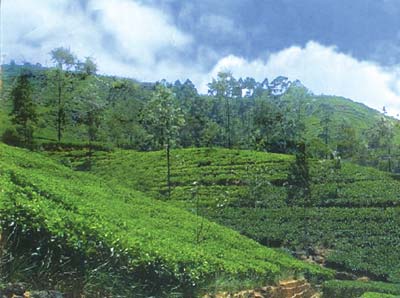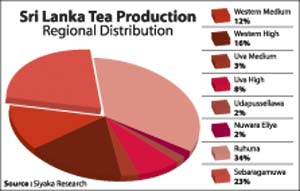2008: good year for tea producers
Sri Lanka’s world of tea has had its fair share of shocks over the
past 10 years.
The Russian currency and banking crisis in 1998, invasion of Kuwait
in August 1990 till Liberation in January 1991 and invasion of Iraq in
March 2003, all took their toll on Sri Lanka’s tea industry.
|

Tea estate in Sri Lanka |
In each instance issues were restricted to one or a cluster of
countries in a limited geographic area. The Russian problem was reduced
in intensity by continuation of normal commercial activity in the
Middle-East / North Africa and other markets. The reverse was the case
when the Middle-East was destabilized.
The global financial crisis does not need any further description at
this point, but it would be necessary to focus on its consequences and
relevance to the tea industry in 2009. What damaged the tea industry the
most was the global nature of the crisis and its impact on most of Sri
Lanka’s critical customers.
The problem was two fold - direct impact on the value chain at micro
level and macro issues such as weakening of currencies, banking crisis,
declining oil prices and recession.
The market for orthodox black tea is the foundation for Sri Lanka’s
Tea Industry. Petro Dollar economics of Russia / CIS and Middle-East /
North Africa have always paid a premium for Orthodox Ceylon’s. Further
these markets absorb a significant proportion of all value added exports
from Sri Lanka.
These pure Ceylon tea brands play a major part in keeping Colombo’s
tea prices above global levels, but could loose heavily in markets that
have currencies that are weak against the SL rupee, on the positive side
tea is an essential food item globally.
Movement of product off the shelves during the recession is evidence
of this. Challenge for suppliers would be the Summer months when
consumption declines. But inventories would be low.
Supply Factors
Fertilizer will be more accessible to tea growers due to lower cost
which are forecast to remain at least till Q3 ‘09. Tea prices, margins
and historic losses, will however determine the number of applications
during the year.
If the weather holds true, production from main producer exporter
countries will remain steady.
Meanwhile the dry Q1 conditions in Kenya, winter in North India and
Vietnam will ensure that the supply side remains tight until April.
Impact on tea production caused by dry weather in Argentina (40 MnKg in
2007) is not yet known. Any short fall in Kenya would have an impact on
prices for small leaf High Growns in Sri Lanka.
In Sri Lanka, Q1 production will be low due to extended dry weather
across the Island, low fertilizer application since Q4 2008 and pruning
of some Small Holder fields during the market crash.
If rains resume mid March crop increases could be expected after New
Year in April. Regional Plantation companies (RPC) are due to negotiate
wages by march ‘09. There could well be a break down given the heavy
losses made by RPCs and pessimistic market out look for 09.
Shipping
Rates have declined with more ships chasing less cargo and fuel costs
sharply lower, Industry sources anticipate that rates will remain in
favour of the shipper at least till Q3 2009.
Money and Banking
We believe that a further deterioration of the currency and banking
situation in Russia and Iran, strong buyers, will have a direct impact
on the market for Ceylon’s Dubai a major trading center and trans
shipment port for Low growns is not very stable at the moment. Pakistan
is in trouble, but is the major player in Kenya.
A crash at the Mombassa auction will hurt High Grown Ceylon’s. The
strong Rupee in Sri Lanka will continue to add cost to our overseas
buyers in comparison with India and Kenya whose currencies have shed
value.
On the other hand Sri Lankan Exporters lose margin to top of high
interest rates while facing inflationary pressure on costs. The global
credit crunch will continue to stifle trade and will restrict traders
more than producers. In Sri Lanka producers and Traders are increasingly
finding it difficult to raise credit.
Out look
The World Bank in its Commodity Markets Review of February 2009
commented “Tea prices rose 13.8 percent on higher imports by China and
several European countries. Cocoa prices rose 9.6 percent on reports
that the cocoa market is heading into deficit for a third consecutive
year, and as arrivals at the port of Abidjan were 27% lower than a year
ago, Coffee (Arabica) prices rose 7.8 percent on reports that the
2009/10 season may face a deficit of 5 million bags (about 4% of global
production) because of reduced output in Brazil”, unquote Elsewhere in
the report it shows that other food prices such as Rice 9.1%, Sugar
7.1%, and Wheat 8.6 have also risen in value. Price increases for tea
are therefore consistent will other essential food items.
On the balance the positive factors out weight negative ones. We
believe therefore that tea prices will hold firm throughout Q1 with a
probable dip in values mid Q2. With pre winter buying resuming in Q3 we
expect a gradual recovery thereafter.
Low growns with a mix of leafy orthodox teas have a more diversified
customer base with few substitutes. If the SL Rupee does not concede
much ground in 2009 these teas would settle at a level in line with
prices that prevailed pre Q4 2007.
High growns are more vulnerable to global forcers and reliant on pure
Ceylon Tea brands to ensure a premium. Q2 and Q3 could be a difficult
period unless supply is Interrupted.
Overall we expect prices to fluctuate over short spells as buyers
will tend to operate on low Inventories, confirmed orders and payment on
sipping. Credit businesses in restricted by the Central bank and will be
at high risk in 2009.

Market review 2008
Auction Performance Overview
It was a good year for tea producers spoilt by a fourth quarter price
slump caused by the international financial crisis. The global commodity
price rise during the year did benefit tea as well in terms of
sentiment. Retailers were able to increase shelf prices after many years
and packers to absorb higher tea costs. The market for Orthodox Ceylon
Teas however had a life of its own.
Sri Lanka sold a total of 300.7 MnKg marginally higher than the
quantity of 299.3 MnKg the previous year. Of this quantity 264.8 MnKg
was sold through the Public Auctions, a significant 9% more than the
previous year.
With the collapse of the market in Q4 2008, the Sri Lanka Tea Board
and the industry collectively agreed to ban Private Sale of Orthodox
leaf tea out side the auction. As a result tea sold by private contract
declined 38% from 55 MnKg in 2007 to 34 MnKg in 2008.
This step proved effective and concentrated all demand in the auction
room. The trading restriction through curtailing freedom of buyers and
sellers has remained in place in Q1 2009 and could well be continued
thereafter.
In the last quarter, 2007 Kenya’s post election violence and
disruption in tea growing areas and the Mombassa port, curtailed
production and movement of tea within and out of the country in Q1 ‘08.
Other African producers were also prevented from reaching the Mombassa
auction as the land route through Kenya was risky.
The Dar es Salam feeder port and Mombassa were also severely
congested. North India was in winter. In Sri Lanka, the Western quality
season had curtailed production and improved quality on the Western
slopes of the higher elevations.
The interruption to supply had its impact on the market in December
2007 and well in to February 2008. Rising oil prices since 2007 boosted
earnings amongst Sri Lanka’s biggest client base; the Middle-East /
North Africa and Russia / CIS. These markets absorb more than 85% of the
country’s exports and ensure than Colombo Auction price levels are at a
premium over other centers.
Sri Lanka’s own pure Ceylon Tea Brands, and International packers
loyal to Ceylon Tea added a further dimension to unique demand at the
Colombo Auction. Colombo price gains were not in isolation. Indonesia,
India and Kenya all had a bull run.
The Colombo auction average for Low Growns kept rising till July and
then the slide began and accelerated in October. Comparatively the High
Grown market was maintained in October but slipped in November and
following the general trend crashed in December.
To be continued
(All details
extracted from Asia Siyaka Commodities (Pvt) Ltd., Annual Report 2008
and Outlook 2009) |





